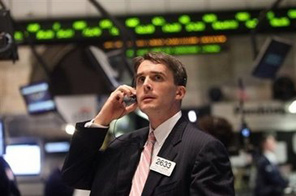Wall Street confidence rising but Sept peril looms
NEW YORK: With confidence rising of a recovery from recession, Wall Street faces historically its worst month of the year with memories still fresh from last September's financial market debacle.
The market streaks to a new month up some 50 percent from lows hit in March, but with investors beginning to turn cautious.
Some analysts say that even if the economy is on the mend from its brutal recession, the market will need to consolidate to avoid getting overextended.
Others point out that further gains will only bring the market back to its levels a year ago before the financial panic deepened in the wake of the collapse of Lehman Brothers and rescue of AIG and others.
In the week to Friday, the Dow Jones Industrial Average managed a 0.4 percent gain to end at 9,544.20, near its highs for the year.
The technology-rich Nasdaq composite advanced 0.39 percent to 2,028.77 while the broad-market Standard & Poor's 500 index edged up 0.27 percent to 1,028.93.
The stock market remains in a twilight zone that provides ammunition for both bulls and bears.
The broad S&P index is up more than 50 percent from March 9 lows -- which would qualify as a roaring bull market but is still off some 34 percent from record highs in 2007, with recovery still elusive from a horrific bear market.
Some jitters are approaching meanwhile about the September effect.
This is the market's worst month, with an average loss of around one percent. Last year's financial market blowup and the failure of Lehman Brothers and a freezeup in credit dragged the S&P down by 9.2 percent for the month.
"The curse of the month of September, the weakest month of the year, is likely to bring in some selling before we even enter the month," said Al Goldman, strategist at Wells Fargo Advisors.
"Also, there is no clear evidence that the market has totally worked off its five-month, 50 percent rally. Fortunately, these are only very short-term problems. Much more important are the improving fundamentals and a reasonable (valuation) ratio."
Andy Brooks, head of equity trading at T Rowe Price, said the market's resilience is a good sign.
"The period of consolidation and holding these levels ought to be fairly bullish," he said. "We've had a furious rally and we should be prepared for some retrenchment but the tone of the market is much improved."
Some market watchers say the snapback from recession could be stronger than has been anticipated, which would help boost corporate profits and the stock market.
"In the US, all signs except for consumer spending are pointing to a strong recovery," said Christian Broda, economist at Barclays Capital.
He said the rebound is showing up in manufacturing for big-ticket durable goods and the housing market and that the rest of the economy should eventually pick up too.
A test will come in Friday's report on August employment. Analysts expect the data to show a loss of 225,000 jobs, which would continue an improving trend but still fall short of job growth. The jobless rate is expected to creep up to 9.5 percent, matching a 26-year high.
Avery Shenfeld at CIBC World Markets said the report could be a disappointment to those looking for recovery signs.
"Employment is now the key missing ingredient in a recovery, but Friday?s jobs data aren't likely to fill in that gap," he said.
"At turning points, economic data are always mixed, so look for much more definitive signs of recovery in the factory (supply managers') index and factory orders."
Over the past week, investors drew encouragement from news that Fed chairman Ben Bernanke would be reappointed to a second term, and from data showing the second-quarter contraction in the economy was unrevised at 1.0 percent, appearing to set the stage for a rebound in the second half of 2009.
Sherry Cooper, chief economist at BMO Capital Markets, revised up her estimate for the US economy to show 3.8 percent growth in the third quarter, pushing up her forcast by a full percentage point.
"While this continues to be subpar growth in an economic recovery, it is far better than the consensus expectation not too long ago," she said.
Bonds firmed as the stock rally faded. The yield on the 10-year Treasury bonds eased to 3.451 percent from 3.556 a week earlier and that on the 30-year bond dropped to 4.208 percent from 4.359. Bond yields and prices move in opposite directions.
The coming week features a manufacturing supply managers survey from the Institute of Supply Management, data on factory orders and monthly auto sales reports.






